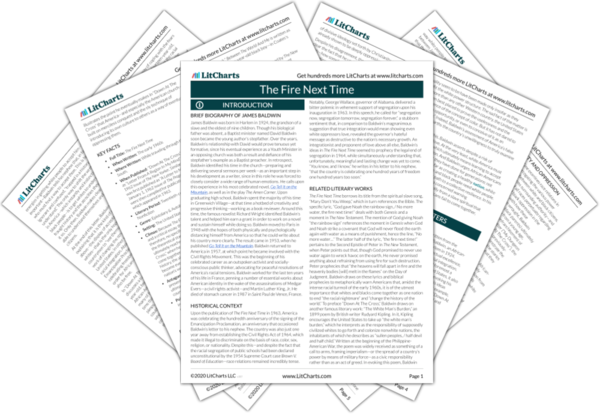Welcome to the LitCharts study guide on James Baldwin's The Fire Next Time. Created by the original team behind SparkNotes, LitCharts are the world's best literature guides.
The Fire Next Time: Introduction
The Fire Next Time: Plot Summary
The Fire Next Time: Detailed Summary & Analysis
The Fire Next Time: Themes
The Fire Next Time: Quotes
The Fire Next Time: Characters
The Fire Next Time: Symbols
The Fire Next Time: Theme Wheel
Brief Biography of James Baldwin

Historical Context of The Fire Next Time
Other Books Related to The Fire Next Time
- Full Title: The Fire Next Time
- When Written: The early 1960s
- Where Written: While traveling through the American South.
- When Published: “Down At The Cross” was first published as “Letter From A Region In My Mind” in the November 17, 1962 issue of The New Yorker. Similarly, “My Dungeon Shook” was first published as “A Letter to My Nephew” in the January 1, 1962 issue of The Progressive. The two pieces were then compiled for publication of The Fire Next Time, which appeared in 1963.
- Literary Period: Twentieth-century African-American Nonfiction
- Genre: Epistolary & Autobiographical Criticism
- Setting: The United States, especially Harlem
- Climax: Because The Fire Next Time is comprised of a letter and a critical essay, there is no discernible plot and, therefore, no specific climax. Rhetorically speaking, though, the theoretical stance Baldwin advances in both pieces ultimately reaches its zenith at the end of “Down At The Cross,” when he suggests that if blacks and whites fail to come together in the face of their shared and troubled history, the already poor state of America’s race relations will become even more catastrophic and destructive to the nation’s well-being.
- Antagonist: The chief antagonistic force that Baldwin presents is an unwillingness to accept others, as this outlook ultimately oppresses African-Americans and divides the country between blacks and whites.
- Point of View: “My Dungeon Shook” is narrated by Baldwin in the first-person, addressing his nephew in the second-person. “Down At The Cross” is told in a more straightforward first-person narration from Baldwin’s perspective.
Extra Credit for The Fire Next Time
Between The World And Me. Ta-Nehisi Coates’s book Between The World And Me, which won the National Book Award for nonfiction in 2015, borrows its title from Richard Wright’s poem by the same name, but the phrase also appears in The Fire Next Time, which was another great influence on Coates. The line in The Fire Next Time reads: “That summer, in any case, all the fears with which I had grown up, and which were now a part of me and controlled my vision of the world, rose up like a wall between the world and me, and drove me into the church.” Like “My Dungeon Shook,” Between The World And Me is written as an epistolary to a fourteen-year-old black boy—in Coates’s case, to his son.
The New Yorker. In 1962, Baldwin was assigned by The New Yorker to write an account of Africa and its then current struggles. Instead, he wrote “Down At The Cross”—at that point entitled “Letter From A Region Of My Mind”—an essay that turned its attention not on Africa, but on America’s own troubles. Despite this inconsistency, the magazine ran the piece.












